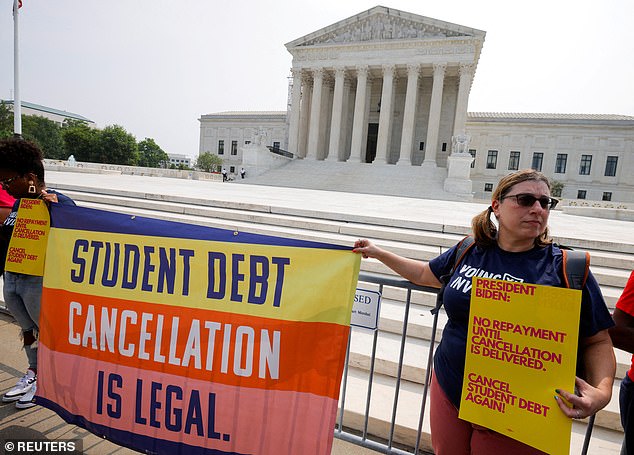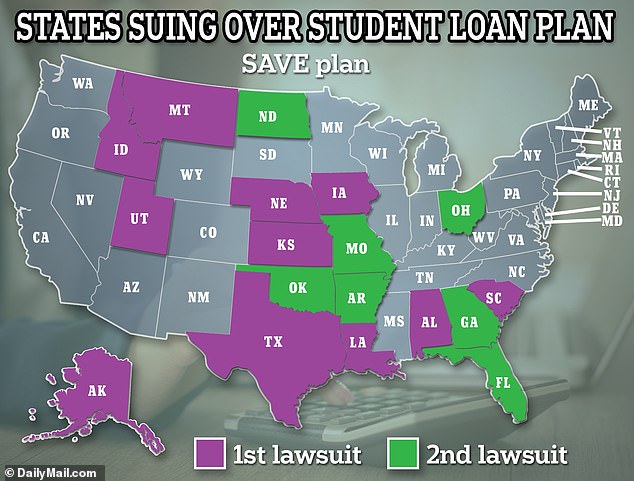So who is REALLY paying for these student loans, Joe? Daily Mail Reveals Who Backs Biden’s $150 BILLION Bid to ‘Buy Votes’ by Wiping Debt
Joe Biden wiped out even more student loan debt on Friday, bringing the total amount he canceled to $153 billion for 4.3 million borrowers.
Republicans labeled Biden’s ongoing efforts to cancel student loan debt as a “scam” to buy votes ahead of the presidential election.
They argue it’s unfair to taxpayers who didn’t go to college or pay back their loans.
But the move to reduce student debt could also have much broader implications for the economy.
According to Marc Goldwein, senior policy director for the Committee for a Responsible Federal Budget, no one will immediately see their taxes increase because of the president’s generosity.
However, it will impact the public in multiple ways as it essentially transfers the debts of individuals onto the nation.
“We are increasing federal borrowing to actually reduce personal student loan debt,” Goldwein told DailyMail.com.
He said the Biden administration has announced it has reduced $153 billion in student debt, but the actual figure is much higher.
If we include the debt that will be forgiven in the future, and the interest that will be forgiven while repayments were suspended during the pandemic, the total amount forgiven is closer to $600 billion.
President Biden spoke Monday at an event focused on student debt forgiveness in Wisconsin. This week, the Biden administration announced that student loan debt forgiveness has totaled $153 billion to date.
Wiping out such a large amount of student debt could have several consequences, including boosting demand, which would lead to inflation.
The costs would therefore be spread to everyone else through higher prices.
Over time, this move would force the US to issue more bonds, and more people will buy those bonds instead of investing in the private sector.
“Americans will feel the upfront costs through slightly higher prices, and over time with slightly lower future incomes,” Goldwein explains.
If a course correction is indeed needed for the skyrocketing national debt as the credit squeeze continues, it could take many different forms.
That could mean taxing the wealthy or cutting government spending, which would affect a large number of Americans in different ways.
“You will see an increase in the federal deficit and larger federal debt over time,” said Tristan Stein, Associate Director for Higher Education at the Bipartisan Policy Center.
“Ultimately, it is current and future generations of taxpayers who will have to pay for the forgiven loans,” Stein said.
“The national debt is $34 trillion. Inflation is making life unaffordable and this administration is now forcing the American people to pay the cost of the student loans that borrowers willingly signed up for.”
In its latest announcement on Friday, the Biden administration said it had canceled another $7.4 billion for 277,000 borrowers.
“Biden’s policies are completely backward and illegal,” Republican House Speaker Mike Johnson responded.
“Biden’s student loan socialism is a scam,” wrote Sen. Joni Ernst (R-Iowa). ‘He’s not ‘cancelling’ – he’s saddled hard-working Americans with a huge bill.’
While Republicans condemn the White House, the Biden administration has argued that the move gives borrowers breathing room and upward economic mobility, allowing them to further contribute to the economy and the middle class.
The White House responded to House Republican criticism by drawing attention to GOP members of Congress who had hundreds of thousands and even millions of dollars in Paycheck Protection Program (PPP) loans forgiven during the coronavirus pandemic.
Policy experts note that there are cost tradeoffs in every policy decision, and at some point everyone pays some share of the cost of other policies.
The counterpoint to the PPP argument, however, was that Congress passed the program while the U.S. economy was in peril, because the intention from the start was that the loans would eventually be forgiven.
Furthermore, rather than being a case of tailor-made forgiveness, it was seen as an effort with broad benefits, although its full scope remains in question.

Supporters of Biden’s efforts to cancel student loan debt leave the Supreme Court after the president’s original plan was blocked in June 2023
But as Republicans and conservatives push back on Biden, Democrats have praised the administration’s efforts on student loans.
Democratic House Whip Katherine Clark said Biden is “delivering on his promise and helping everyday Americans get by and get ahead.”
And the Biden administration has promised it won’t stop there.
On Monday, Biden announced additional measures to cancel student loan debt, which combined with previous actions, could impact more than 30 million borrowers.
Between the SAVE program and new actions, the Penn Wharton Budget Model estimates that the move would cost a total of $559 billion over ten years, including an additional $84 billion for the new proposals unveiled Monday, on top of the $475 billion dollars previously estimated for the SAVE plan.

But the White House’s efforts are not without legal challenges.
Eighteen Republican-led states have already sued the Biden administration over the SAVE plan.
The two separate lawsuits targeting the SAVE plan came after Republican officials managed to stall the president’s original student debt relief plan and take it all the way to the Supreme Court, which blocked the effort last June.
The Biden administration previously estimated that the SAVE plan would cost $156 billion over 10 years. The Congressional Budget Office said that figure is closer to $230 billion.
What remains to be seen is how higher education institutions and prospective students respond to efforts to cancel student loan debt. Experts wonder whether it will prompt colleges to raise costs or whether prospective students will take out larger loans under the assumption they can be forgiven.
It could lead to future governments taking additional steps to cancel debt. But there is also the opposite where future governments roll back forgiveness while the debts of emboldened borrowers continue to swell.
